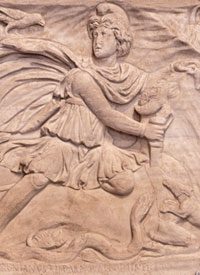
The proud Roman general stood with his commanders and retinue as the wild hillsmen, dressed in the ragged but still-flamboyant clothes of corsairs, fell before him in turn, begging for clemency. It was about 75 B.C. in the rugged hills near Coracesium in Cilicia, an untamed region along the coast of southwestern Asia Minor, and the Cilician pirates, possibly the most successful race of brigands the world has ever seen, were surrendering to the Roman general Pompey.
Pompeius Magnus, as he was afterwards styled, would go on to conquer the Levant and to challenge Julius Caesar for supremacy over the fledgling Roman Empire, but his lightning-swift campaign against the Cilician pirates was perhaps his finest moment. The pirates, taking advantage of Roman naval weakness during a span of decades that saw Rome wracked by civil war, had controlled much of the Mediterranean, as far west as the Balearic Islands.* Now, thanks to Pompey’s masterful combination of resolute military action and unconditional clemency for all pirates who surrendered to him in person, the once-feared Cilicians were admitted to the Roman Empire and given the opportunity to live respectable lives. Most, according to Plutarch’s account of events, accepted Pompey’s offer. They were resettled in various parts of the Roman dominion, bringing their families and possessions with them. They also, according to Plutarch, brought with them a peculiar system of religious beliefs and practices, one of the so-called “mystery cults” typical of the pre-Christian Mediterranean.
The cult of the Mithras was doubtless regarded at first as just another Oriental import, a product of Mediterranean multi-culturalism. But it grew into the most formidable occult secret society in the ancient world, claiming emperors and legionaries alike in its membership. At the peak of its power and influence — when it held hostage the very machinery of empire — it threatened to fling the Roman world back to its pagan roots and to eradicate the young Christian faith.
No one knows the precise origins of the cult devoted to the Persian deity Mithras, which came to be known as the Mithraic mysteries or Mithraism. Plutarch says only that the Cilician pirates “offered strange sacrifices upon Mount Olympus, and performed secret rites or religious mysteries, among which those of Mithras have been performed to our own time [i.e., the second century A.D., roughly two centuries after Pompey’s time], having received their previous institution from them.” It is also possible that the mysteries of Mithras, like certain other mystery cults in Roman dominions, were popularized by the mysterious “Chaldeans,” itinerant sorcerers from the East who were periodically expelled from Roman territory for encouraging the formation of subversive cultic secret societies.
From Persian Antiquity
The name of Mithras is the Latinized equivalent of Mithra, an important deity in Persian Zoroastrianism. This god was worshipped far back into remotest antiquity by the ancestors of the Persians and Indians alike (in the Vedic Hymns of ancient India, he is known as Mitra, ‘the friend’). To the Persians, he was the god of oaths and covenants, and was worshipped far and wide across central Asia and the Middle East, from Armenia to the empire of Kushan in modern-day Afghanistan.
The mystery cult, meanwhile, was a distinctively Mediterranean form of religious worship, a cult within a cult, as it were, in which esoteric beliefs withheld from the general populace were taught and secret rites performed. Among the ancient Greeks, the mysteries of Eleusis or Demeter proved most enduringly popular, while in Egypt, the mysteries of Isis reigned supreme. On Asia Minor the mysteries of Cybele, a goddess popular with the Phrygians, flourished.
One particular mystery cult — that of Bacchus, the god of wine and revelry — acquired a sinister reputation in Rome in the second century B.C. Introduced by a mysterious Greek immigrant, the cult of Bacchus allegedly practiced human sacrifices and all manner of debauchery at its secret nighttime orgies. And the cult sought not only to corrupt Roman morals but also to take control of Roman government. “Never,” said Spurius Postumius, the Roman consul who first exposed the cult of Bacchus before the Roman Senate in 186 B.C., “has there been so much wickedness in this commonwealth, never wickedness affecting so many people, nor manifesting itself in so many ways…. Their [the Bacchan votaries’] impious conspiracy still confines itself to private outrages, because it has not yet strength enough to overthrow the state. But the evil grows with every passing day…. It aims at the supreme power of the state.” Fortunately for Rome, the Senate heeded Postumius’ warning and suppressed the cult of Bacchus. But the episode showed the potency of cultic secret societies, and their potential, at least in the ancient Mediterranean world, to unravel moral fabric and even threaten the integrity of the state.
The mystery cult of Mithras appears to have been structurally a Roman innovation, using certain features of Persian religion and mythology for its own purposes. Unfortunately, we know little about its growth or operations until more than a century after Pompey. Not until the ascendancy of Nero does the name Mithra reappear in Rome.
One of the accomplishments of Rome’s evilest emperor was to bring the Armenian king Tiridates to Rome for his coronation. As Tiridates prostrated himself before the Roman emperor, he informed Nero that he would worship him as he worshipped the great god Mithra (in a stroke of historical irony, a later Armenian king of the same name, Tiridates the Great, converted to Christianity and was responsible for Armenia’s becoming the first state to embrace the new religion). Nero in his turn is supposed to have expressed great interest in being inducted into the mysteries of Zoroastrianism by the magi who accompanied Tiridates to Rome. Whether the Armenian king was an adherent of the mystery cult per se, or whether Nero became himself a devotee, is impossible to prove. But the episode suggests that, at very minimum, the worship of Mithra was a familiar concept in Rome by the mid-first century A.D.
What the archaeological record bears out is that Mithraism was becoming widespread in the Roman Empire by the end of the first century of our era. The earliest Mithraic temples, or mithraea, of which we have record date from roughly 90 to 110 A.D., in the German provinces. The mysteries of Mithras must have been well-established by that time in the Roman heartland, the Italian peninsula. By the middle of the second century, the cult had spread throughout Roman territory, from the Middle East to the British Isles, displaying a vitality that only the young Christian faith could match.
Imperial Sponsors
The cult of Mithras seems to have begun in the Roman military, eventually becoming a cult not only of Roman legionaries, but of merchants and government officials as well. Nero was the first Roman emperor whose name was associated with the god Mithras, but he was far from the last.
The turning point for Mithraism, which apparently enjoyed at least a measure of tolerance from the Roman government from its inception, was the administration of the emperor Commodus, the bestial son of Marcus Aurelius, who reigned from 180 to 190 A.D. Commodus is remembered chiefly for his savagery and many perversions, exceptional even by the standards of Roman emperors. Possessed of none of the equanimity and wisdom of his father nor of the saintly virtues of his grandfather, the aptly named Pius Antoninus, Commodus managed to undo in a few short, blood-soaked years much of the progress logged by Roman civilization during the previous several generations of comparative peace and progress. He was also the first Roman emperor of record to have been a full-blown initiate into the mysteries of Mithras. Commodus, says Franz Cumont, a pioneer in modern Mithraic studies, “was admitted among their adepts and participated in their secret ceremonies, and the discovery of numerous votive inscriptions, either for the welfare of this prince or bearing the date of his reign, gives us some ink-ling of the impetus which this imperial conversion imparted to the Mithraic propaganda. After the last of the Antonine emperors had thus broken with the ancient prejudice, the protection of his successors appears to have been definitely assured to the new religion.”
While we have no details of how Commodus’ involvement in the secret cult may have influenced his policymaking, his association with Mithras set a disturbing precedent — namely, that most emperors associated with the cult displayed more than ordinary levels of brutality and depravity, and a peculiar animus for Christianity.
Of the beliefs and rituals of Mithraism, we know very little, despite the abundant archaeological evidence. Mithraism has left us no religious texts comparable to, say, the epistles of Paul, the Talmud, or the patristic writings. We do know that it was a secret religious society to which only men were admitted. According to St. Jerome, there were seven initiatory grades in Mithraism, beginning with Corax (raven). The others, from lowest to highest, were Nymphus (bridegroom), Miles (soldier), Leo (lion), Perses (Persian), Heliodromus (sun-runner), and Pater (father). Of these the first two appear to have been preparatory levels, and induction into the rank of Miles was the real starting point for progression within the Mithraic hierarchy.
Mithraism had a belief system characterized by vivid myths and maddeningly obscure symbolism. A typical mithraeum, an underground house of worship used by devotees of Mithras, was constructed to resemble a world-cavern, a metaphor of the cosmos favored in the ancient Middle East. The dominant feature of every mithraeum was a depiction, usually carved in stone, of the central myth of Mithras: the tauroctony or slaying of the bull of heaven. Mithras is depicted as a youthful hero wearing a characteristic Phrygian cap, killing the bull with a dagger. Surrounding and harassing the hapless bull are a dog, scorpion, raven, and snake, while flanking the scene stand two other youths holding torches (dadophori), Cautes and Cautopates, of whom the latter holds his torch with the tip pointed earthward.
Devilish Details
The precise meaning of this remarkable tableau is still disputed; nowhere in the Persian Zoroastrian canon as we have received it is there any reference to Mithra slaying a bull. Cumont perceived in Cautes and Cautopates, with their opposing torches, an allusion to the radical dualism of the Zoroastrian faith, the notion that good and evil must be regarded as opposite and completely equal forces.
In the vivid paintings on the walls of the well-preserved mithraeum at Dura-Europos in Syria, there are also images of Mithras as an equestrian hunter — the famous “mighty hunter” motif associated with Mesopotamian monarchs and gods since time immemorial — and of Mithras forging his pact with the sun god Sol, whence Mithras’ most famous epithet, “Sol Invictus,” or “Unconquerable Sun.”
The other characteristic piece of Mithraic iconography, the so-called leontocephalous or lion-headed deity entwined with serpents, is easier to interpret. This terrifying figure, displayed in many surviving mithraea, has been identified with the Greek Kronos and Egyptian Kore, the god of time, but in several mithraea, this idol is captioned “Deus Arimanius.” Arimanius is the Latin form of Persian Ahriman, meaning “evil spirit.” Ahriman was the Satan of Zoroastrianism, and his presence in Mithraic sancta speaks volumes about the real nature of this mystery cult. Moreover, in the traditional Zoroastrian religion, it is Ahriman — not Mithra — who, according to historian of religion Yuri Stoyanov, “brings death to the ‘Lone-Created’ bull in the violent act of the first ‘creative murder’ which sparked off the cycle of being and generation.” In Stoyanov’s view:
The Mithraic Deus Arimanius is thus taken to show that Roman Mithraism derived from pre-Zoroastrian and later forbidden daevic [i.e., diabolical] forms of Mithra-worship which were associated with the dreaded ‘mystery of the sorcerers’ and which were sustained in Mesopotamia and Asia Minor.
Of the rites and observances of Mithraism we know comparatively little. From images in a Mithraic grotto at modern-day Capua, we learn that initiates were blindfolded and subjected to various severe trials by a mystagogus in a white tunic. It appears, from the testimony of Tertullian, that initiates underwent various purification ceremonies, swore oaths of secrecy, and received brands on the hands or forehead betokening their membership in the order. According to M. J. Vermaseren, “on several [ancient] portraits, even on portraits of emperors, these tattoo marks are clearly visible, but on the forehead, in place of the hands.”
A much more abominable practice, human sacrifice, may have been associated with Mithraism as well, though few modern researchers, aside from the scrupulous Vermaseren, bother to acknowledge it. The Christian historian Socrates, in the fourth or fifth century, alleged that Greeks in Alexandria “killed men” while celebrating the mysteries, despite the fact that human sacrifice had been explicitly forbidden in Roman dominions since at least the time of Tiberius. At a mithraeum in Saarburg, the skeleton of a man between 30 and 40 years old was discovered lying face downwards with his wrists manacled behind his back with an iron chain — very likely a Mithraic sacrificial victim. Human sacrifices to Mithras have also been ascribed — although never proven — to two Roman emperors and Mithras devotees, Commodus and Julian.
Son of God vs. “Sun God”
It appears that, from the time of Commodus onward, nearly every Roman emperor was associated with the cult of Mithras in some way. In the early third century, a shrine to Mithras was built on the grounds of the palace of the Augusti. Elagabalus, another exceptionally depraved ruler in the tradition of Nero and Commodus, replaced Jupiter with the Unconquerable Sun, Deus Sol Invictus, as the head of the Roman pantheon, while Aurelian instituted an imperial cult dedicated to the same god. Diocletian, Licinius, and Galerius dedicated a temple to Mithras in Carnuntum in 307 A.D.; it was Galerius, moreover, who instituted one of the greatest persecutions against the Christians, because of his well-documented zeal for pagan tradition and worship. Constantine the Great, too, was at least associated with the cult of the Unconquerable Sun/Mithras, though whether he was an initiate into the mysteries is unclear. Rome’s last pagan emperor, Julian, was inducted into the mysteries of Mithras while yet in his teens by Maximus of Ephesus, and in his efforts to suppress Christianity and to restore paganism to full flower, compelled the citizens at Constantinople — by then the capital of the empire — to worship Mithras.
The early Christian church regarded the cult of Mithras as its mortal enemy. The mythology and liturgy of Mithraism were held up as deliberate mockeries of Christian doctrine and sacraments. The youthful hero-god Mithras was believed to be a caricature of Jesus Christ, while Mithraic initiatory rites were considered counterfeit baptisms. It is possibly Mithraism that the author of the Book of Revelation had in mind in associating the harlot of Babylon with “mystery,” and the Antichrist with the infamous “mark of the beast” (which mark, analogous to the brands inflicted on Mithraic initiates, was to be placed on the right hand or on the forehead). Whatever the case, there is every likelihood that, had not Constantine and all of his successors save Julian not chosen to adopt Christianity, the Western world might very well have become Mithraic instead.
The demise of Mithraism was as shrouded in obscurity as its origins. After the death of Julian during his unsuccessful campaign in Persia, the recrudescent mysteries of Mithras were swiftly suppressed. Julian’s Mithraic preceptor Maximus was put to death along with other unrepentant votaries of Mithras, but whether the cult managed to disappear underground or otherwise reinvent itself and persist in some other guise is unknown. Some have suggested a continuity of tradition between Mithraism and Manichaeism, the so-called “religion of light” founded by the Persian heretic Mani and promulgated across much of the Orient. Others have found in the underground heresies of Medieval Europe, especially the Paulicians and the Bogomils, lineal successors to Mithraism and the other mystery cults.
Whatever its final fate, the cult of Mithras is perhaps the best-documented instance of a cult of empire, a secret, oath-bound society of elites that, for several centuries, was the power behind the throne of the mightiest realm the world had ever seen. It was apparently the mysteries of Mithras that gave cohesion to Rome’s far-flung legions and ideological grounding for the autocratic behavior of her emperors. If the emperor was the embodiment of the Unconquerable Sun, who could pretend to stand against him? From what little we have been able to glean of the religion of Mithras and of its most prominent imperial adherents, we are fortunate that this last and greatest of the ancient mystery cults did not carry the day in its epic struggle with Christianity for the hearts and minds of Rome.
* See “Fear & Fatal Power” by Joe Wolverton II in the May 24, 2010 issue of TNA.



